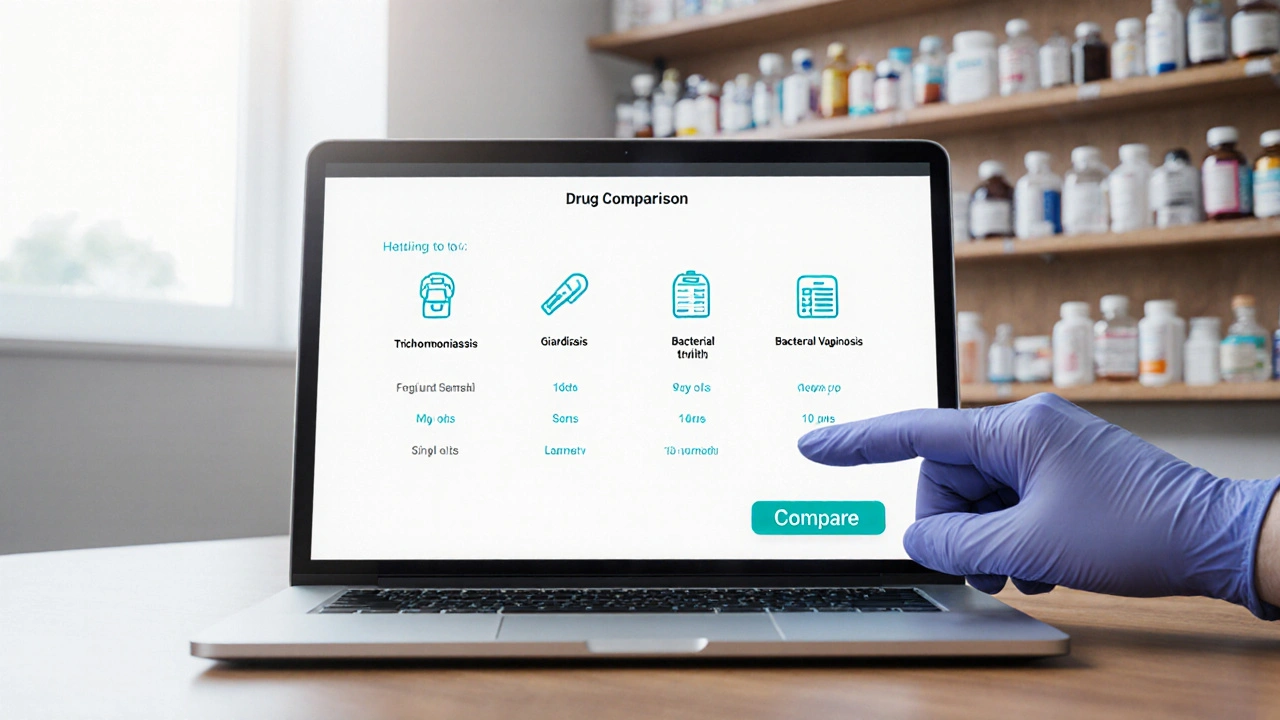Antiprotozoal Drug Comparison Tool
Tinidazole
Dosing: Single 2g dose for trichomoniasis/giardiasis
Half-life: ~13 hours
Cost: $40-$55
Metronidazole
Dosing: 500mg twice daily for 7 days for trichomoniasis
Half-life: ~8 hours
Cost: $15-$25
Secnidazole
Dosing: Single 2g dose for trichomoniasis/giardiasis
Half-life: ~12 hours
Cost: $70-$90
Ornidazole
Dosing: 500mg twice daily for 5-7 days
Half-life: ~14 hours
Cost: $60-$80
Nitazoxanide
Dosing: 500mg twice daily for 3 days (off-label)
Half-life: ~3 hours
Cost: $120-$150
Recommended Drug Based on Your Selection
When a doctor prescribes an antiprotozoal medication, patients often wonder whether Tinidazole is the right choice or if another drug might work better. This guide lines up Tinidazole against the most common alternatives, breaks down the key factors that matter for safety and effectiveness, and gives you a quick‑reference table to spot the differences at a glance.
Quick Takeaways
- Tinidazole offers a shorter course (single dose) for trichomoniasis and giardiasis compared with Metronidazole.
- Metronidazole is the cheapest option but carries a higher risk of nausea and a metallic taste.
- Secnidazole provides a single‑dose regimen similar to Tinidazole but is less widely available in Australia.
- Pregnancy safety: Metronidazole is Category B (US), Tinidazole is Category C - discuss with your clinician.
- Drug interactions: all nitroimidazoles inhibit CYP2C9, so watch out for warfarin and oral contraceptives.
What Is Tinidazole?
Tinidazole is a synthetic nitroimidazole antibiotic launched in the 1970s. It targets anaerobic bacteria and protozoa by disrupting DNA synthesis, leading to cell death. In clinical practice it’s most often used for:
- Trichomonas vaginalis infection (single 2g dose).
- Giardiasis (single 2g dose or 500mg twice daily for three days).
- Bacterial vaginosis caused by Gardnerella species.
Key attributes:
- Half‑life: ~13hours, allowing once‑daily dosing.
- Bioavailability: ~90% when taken with food.
- Common side effects: mild nausea, headache, metallic taste.

Common Alternatives
While Tinidazole is effective, three other nitroimidazoles compete for the same treatment slots.
Metronidazole
Metronidazole is the oldest and cheapest nitroimidazole. It’s licensed for the same infections and also for amoebic liver abscess, anaerobic skin infections, and certain dental infections. Typical regimens range from 500mg twice daily for 5‑7days (trichomoniasis) to a single 2g dose (giardiasis).
Secnidazole
Secnidazole offers a true single‑dose option (2g) for trichomoniasis and giardiasis, similar to Tinidazole, but it’s approved in the US and Europe and only recently entered the Australian market under limited supply.
Ornidazole
Ornidazole is popular in Asia and South America. It has a longer half‑life (~14hours) and is usually given as 500mg twice daily for 5‑7days. Its side‑effect profile mirrors Metronidazole, but it’s more expensive in most pharmacies.
Nitazoxanide
Nitazoxanide works through a different mechanism (interfering with parasite pyruvate:ferredoxin oxidoreductase). It’s often reserved for cryptosporidiosis and is given as 500mg twice daily for 3days. While not a nitroimidazole, it shows up in comparative tables because clinicians sometimes switch to it when patients cannot tolerate the classic drugs.
Side‑by‑Side Comparison
| Attribute | Tinidazole | Metronidazole | Secnidazole | Ornidazole | Nitazoxanide |
|---|---|---|---|---|---|
| Typical Dose (Trichomoniasis) | 2g single dose | 500mg twice daily for 7days | 2g single dose | 500mg twice daily for 5‑7days | 500mg twice daily for 3days (off‑label) |
| Half‑life | ~13h | ~8h | ~12h | ~14h | ~3h |
| Cost (AU$ per course) | ≈$40‑$55 | ≈$15‑$25 | ≈$70‑$90 | ≈$60‑$80 | ≈$120‑$150 |
| Common Side Effects | Nausea, headache, metallic taste | Nausea, metallic taste, dark urine | Similar to Tinidazole | Similar to Metronidazole | Abdominal pain, mild diarrhea |
| Pregnancy Category (US) | C (use only if benefits outweigh risks) | B (generally considered safe) | C | C | B |
| Key Drug Interactions | Warfarin, oral contraceptives (CYP2C9 inhibition) | Alcohol (disulfiram‑like reaction), warfarin | Same as Tinidazole | Same as Metronidazole | Rifampin (enzyme induction) |
How to Choose the Right Drug
Picking a therapy isn’t just about price. Consider these decision points:
- Treatment duration. If you can’t stick to a week‑long schedule, a single‑dose option (Tinidazole or Secnidazole) reduces the chance of missed doses.
- Side‑effect tolerance. Patients with a history of severe nausea may prefer Metronidazole’s lower incidence of headaches, but the metallic taste can be a deal‑breaker.
- Pregnancy status. For pregnant patients, Metronidazole is usually the first pick because it’s Category B, while Tinidazole and Secnidazole require a risk‑benefit discussion.
- Drug interactions. Anyone on warfarin, oral contraceptives, or lithium should be warned about the CYP2C9 inhibition shared by most nitroimidazoles.
- Availability and cost. In regional Australia, Metronidazole is stocked in most pharmacies, whereas Tinidazole may need a special order, adding time and cost.
Talk with your clinician about these factors. A short conversation can prevent a repeat prescription or an unexpected side effect.

Frequently Asked Questions
Can I take Tinidazole and Metronidazole together?
No. Both drugs belong to the nitroimidazole class and work in the same way. Using them together adds no benefit and increases the risk of side effects.
Is a single dose of Tinidazole as effective as a week of Metronidazole?
Clinical trials show comparable cure rates for trichomoniasis and giardiasis when the single 2g dose of Tinidazole is taken with food. The key is adherence-missing a day of Metronidazole can lower success.
What should I avoid while on Tinidazole?
Alcohol should be avoided for at least 24hours before and after the dose because of a possible disulfiram‑like reaction. Also, limit heavy meals that are very high in fat; they can delay absorption.
Is Tinidazole safe for children?
Yes, it’s approved for pediatric use down to 6months for giardiasis, but the dose is weight‑based (30mg/kg). Always follow a doctor’s prescription.
How do I store Tinidazole?
Keep the tablets in a cool, dry place away from direct sunlight. Do not refrigerate unless the label specifically says so.
Bottom line: Tinidazole shines when you need a quick, single‑dose cure, but Metronidazole remains the budget‑friendly workhorse for most patients. Weigh cost, treatment length, pregnancy status, and drug interactions to land on the safest, most effective option for you.

Vivek Koul
October 3, 2025 AT 17:55The comparative data presented demonstrates that tinidazole's single‑dose regimen offers a distinct advantage in patient adherence; however the cost differential and pregnancy classification warrant careful consideration.
Frank Reed
October 5, 2025 AT 17:55Hey man, great breakdown! I think the single dose of tinidazole is super convenient, especially if you’re busy. For folks on a budget Metronidazole is still the go‑to, but the ease of tinidazole can save a lot of headaches. Definitely definatly worth a look. Keep up the good work!
Bailee Swenson
October 7, 2025 AT 17:55Honestly, if you’re not willing to pay a premium, tinidazole is just a marketing gimmick 😒. The cheaper metronidazole does the same job with decades of safety data. Stop over‑hyping the “single dose” miracle 🙄.
tony ferreres
October 9, 2025 AT 17:55One could argue that the value of a medication extends beyond pharmacokinetics; it intertwines with patient autonomy and trust 🌱. While tinidazole’s convenience is appealing, the ethical weight of prescribing a Category C drug during pregnancy cannot be ignored. It’s a delicate balance between efficacy and precaution 🙏.
James Knight
October 11, 2025 AT 17:55Your post sugar‑coats a cheap pharma cash‑grab.
Ajay D.j
October 13, 2025 AT 17:55Nice effort on laying out the comparison. If you keep this clear style, more people will understand their options and feel confident in choosing the right treatment. Good luck!
Dion Campbell
October 15, 2025 AT 17:55The exposition, while thorough, borders on the pedantic. One expects a more nuanced discourse when addressing such a pivotal therapeutic choice. Nonetheless, the data does not lie.
Burl Henderson
October 17, 2025 AT 17:55From a pharmacoeconomic perspective, the therapeutic index of tinidazole justifies its higher acquisition cost in high‑adherence cohorts. Moreover, the reduced dosing frequency mitigates the risk of sub‑therapeutic plasma troughs, which is a critical factor in resistance mitigation.
Leigh Ann Jones
October 19, 2025 AT 17:55The comparison table provides a clear visual hierarchy of the key pharmacological parameters across the nitroimidazole class. When evaluating tinidazole, the single 2 g dose stands out as a patient‑friendly regimen that can dramatically improve compliance, especially in populations with limited access to healthcare facilities. However, the cost of $40‑$55 per course remains a barrier for uninsured individuals or those in low‑income regions. Metronidazole, by contrast, is markedly less expensive, often available for under $20, which makes it the default first‑line agent in many public health programs. Its longer treatment duration of 5‑7 days, while effective, introduces a higher risk of missed doses, potentially compromising cure rates. The half‑life differences are modest, with tinidazole’s 13 hours offering once‑daily dosing versus metronidazole’s 8‑hour profile that necessitates twice‑daily administration. From a safety standpoint, both drugs share similar adverse effect profiles, including nausea and a metallic taste, yet tinidazole appears to cause fewer instances of dark urine, a nuisance often reported with metronidazole. The pregnancy categories further differentiate the agents; metronidazole’s Category B status generally permits use throughout pregnancy, whereas tinidazole’s Category C advises caution and risk‑benefit analysis. This distinction is especially pertinent for clinicians managing pregnant patients with trichomoniasis, where the teratogenic potential is a key consideration. Drug‑drug interactions also play a critical role; both agents inhibit CYP2C9, affecting warfarin metabolism, but metronidazole uniquely precipitates a disulfiram‑like reaction with alcohol. The single‑dose convenience of secnidazole, though comparable to tinidazole, is hampered by limited availability and a higher price point in many markets. Ornidazole, while effective, suffers from similar cost issues and lacks the compelling dosing simplicity of tinidazole. Nitazoxanide introduces a different mechanism of action and may be reserved for cases where nitroimidazoles are contraindicated, yet its high cost and shorter half‑life diminish its appeal for routine use. Clinicians must also weigh the potential for resistance development, which historically has been lower with the single‑dose regimens due to reduced exposure time. Ultimately, the choice of agent should be individualized, taking into account patient adherence potential, financial constraints, pregnancy status, and concomitant medications. In practice, many providers start with metronidazole for its affordability and switch to tinidazole only when adherence is a concern or when the infection persists despite adequate therapy.
Sarah Hoppes
October 21, 2025 AT 17:55They dont want you to know that the cheap meds are designed to keep you sick
Robert Brown
October 23, 2025 AT 17:55Dont trust the cheap meds.
Erin Smith
October 25, 2025 AT 17:55Great summary keep it up you’re helping a lot of people!
George Kent
October 27, 2025 AT 16:55🇦🇺 Aussie doctors have known the benefits of tinidazole for ages!!! It’s time we stop blindly copying outdated US guidelines!!! #AussieMedics!!!
Jonathan Martens
October 29, 2025 AT 16:55Oh sure, because a single dose magically solves all adherence issues, right?
Jessica Davies
October 31, 2025 AT 16:55Actually, the emphasis on single‑dose convenience ignores the fundamental principle that longer courses allow better monitoring of side‑effects and patient response.
Kyle Rhines
November 2, 2025 AT 16:55The data presented is accurate, however the omission of any discussion on pharmaceutical lobbying is conspicuous and suggests bias.
Lin Zhao
November 4, 2025 AT 16:55Could you explain how the CYP2C9 inhibition specifically affects oral contraceptive efficacy? 🤔
Laneeka Mcrae
November 6, 2025 AT 16:55In reality, the decision matrix for antiprotozoal therapy is straightforward: assess pregnancy category, evaluate cost, and consider dosing frequency. Tinidazole only wins when adherence is the sole barrier, otherwise metronidazole remains the evidence‑based first choice.